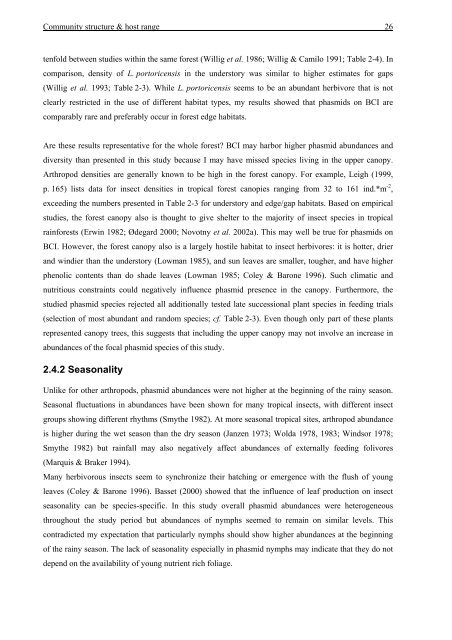ecology of phasmids - KLUEDO - Universität Kaiserslautern
ecology of phasmids - KLUEDO - Universität Kaiserslautern
ecology of phasmids - KLUEDO - Universität Kaiserslautern
Create successful ePaper yourself
Turn your PDF publications into a flip-book with our unique Google optimized e-Paper software.
Community structure & host range 26<br />
tenfold between studies within the same forest (Willig et al. 1986; Willig & Camilo 1991; Table 2-4). In<br />
comparison, density <strong>of</strong> L. portoricensis in the understory was similar to higher estimates for gaps<br />
(Willig et al. 1993; Table 2-3). While L. portoricensis seems to be an abundant herbivore that is not<br />
clearly restricted in the use <strong>of</strong> different habitat types, my results showed that <strong>phasmids</strong> on BCI are<br />
comparably rare and preferably occur in forest edge habitats.<br />
Are these results representative for the whole forest? BCI may harbor higher phasmid abundances and<br />
diversity than presented in this study because I may have missed species living in the upper canopy.<br />
Arthropod densities are generally known to be high in the forest canopy. For example, Leigh (1999,<br />
p. 165) lists data for insect densities in tropical forest canopies ranging from 32 to 161 ind.*m -2 ,<br />
exceeding the numbers presented in Table 2-3 for understory and edge/gap habitats. Based on empirical<br />
studies, the forest canopy also is thought to give shelter to the majority <strong>of</strong> insect species in tropical<br />
rainforests (Erwin 1982; Ødegard 2000; Novotny et al. 2002a). This may well be true for <strong>phasmids</strong> on<br />
BCI. However, the forest canopy also is a largely hostile habitat to insect herbivores: it is hotter, drier<br />
and windier than the understory (Lowman 1985), and sun leaves are smaller, tougher, and have higher<br />
phenolic contents than do shade leaves (Lowman 1985; Coley & Barone 1996). Such climatic and<br />
nutritious constraints could negatively influence phasmid presence in the canopy. Furthermore, the<br />
studied phasmid species rejected all additionally tested late successional plant species in feeding trials<br />
(selection <strong>of</strong> most abundant and random species; cf. Table 2-3). Even though only part <strong>of</strong> these plants<br />
represented canopy trees, this suggests that including the upper canopy may not involve an increase in<br />
abundances <strong>of</strong> the focal phasmid species <strong>of</strong> this study.<br />
2.4.2 Seasonality<br />
Unlike for other arthropods, phasmid abundances were not higher at the beginning <strong>of</strong> the rainy season.<br />
Seasonal fluctuations in abundances have been shown for many tropical insects, with different insect<br />
groups showing different rhythms (Smythe 1982). At more seasonal tropical sites, arthropod abundance<br />
is higher during the wet season than the dry season (Janzen 1973; Wolda 1978, 1983; Windsor 1978;<br />
Smythe 1982) but rainfall may also negatively affect abundances <strong>of</strong> externally feeding folivores<br />
(Marquis & Braker 1994).<br />
Many herbivorous insects seem to synchronize their hatching or emergence with the flush <strong>of</strong> young<br />
leaves (Coley & Barone 1996). Basset (2000) showed that the influence <strong>of</strong> leaf production on insect<br />
seasonality can be species-specific. In this study overall phasmid abundances were heterogeneous<br />
throughout the study period but abundances <strong>of</strong> nymphs seemed to remain on similar levels. This<br />
contradicted my expectation that particularly nymphs should show higher abundances at the beginning<br />
<strong>of</strong> the rainy season. The lack <strong>of</strong> seasonality especially in phasmid nymphs may indicate that they do not<br />
depend on the availability <strong>of</strong> young nutrient rich foliage.

















